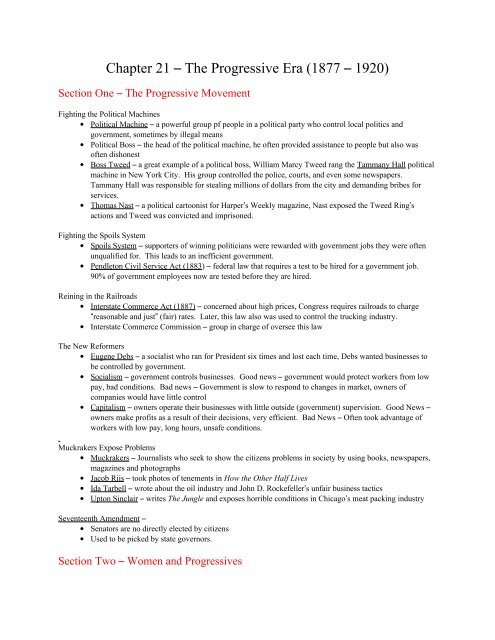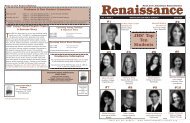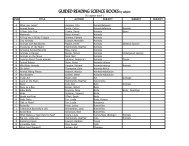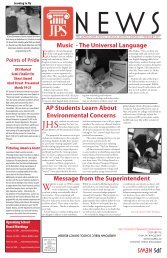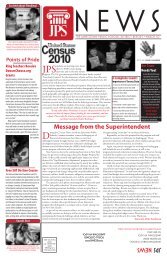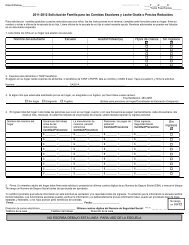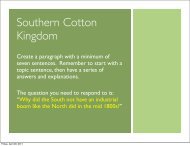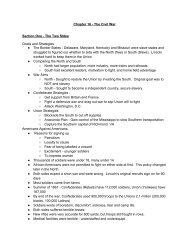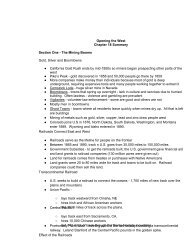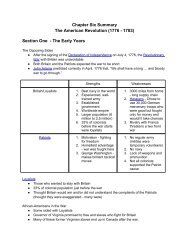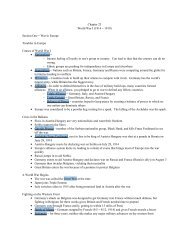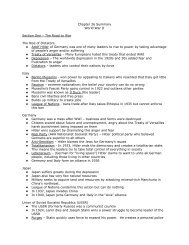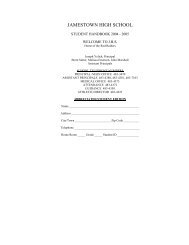21 - Progressive Era - Jamestown School District
21 - Progressive Era - Jamestown School District
21 - Progressive Era - Jamestown School District
Create successful ePaper yourself
Turn your PDF publications into a flip-book with our unique Google optimized e-Paper software.
Chapter <strong>21</strong> – The <strong>Progressive</strong> <strong>Era</strong> (1877 – 1920)<br />
Section One – The <strong>Progressive</strong> Movement<br />
Fighting the Political Machines<br />
• Political Machine – a powerful group pf people in a political party who control local politics and<br />
government, sometimes by illegal means<br />
• Political Boss – the head of the political machine, he often provided assistance to people but also was<br />
often dishonest<br />
• Boss Tweed – a great example of a political boss, William Marcy Tweed rang the Tammany Hall political<br />
machine in New York City. His group controlled the police, courts, and even some newspapers.<br />
Tammany Hall was responsible for stealing millions of dollars from the city and demanding bribes for<br />
services.<br />
• Thomas Nast – a political cartoonist for Harper’s Weekly magazine, Nast exposed the Tweed Ring’s<br />
actions and Tweed was convicted and imprisoned.<br />
Fighting the Spoils System<br />
• Spoils System – supporters of winning politicians were rewarded with government jobs they were often<br />
unqualified for. This leads to an inefficient government.<br />
• Pendleton Civil Service Act (1883) – federal law that requires a test to be hired for a government job.<br />
90% of government employees now are tested before they are hired.<br />
Reining in the Railroads<br />
• Interstate Commerce Act (1887) – concerned about high prices, Congress requires railroads to charge<br />
“reasonable and just” (fair) rates. Later, this law also was used to control the trucking industry.<br />
• Interstate Commerce Commission – group in charge of oversee this law<br />
The New Reformers<br />
• Eugene Debs – a socialist who ran for President six times and lost each time, Debs wanted businesses to<br />
be controlled by government.<br />
• Socialism – government controls businesses. Good news – government would protect workers from low<br />
pay, bad conditions. Bad news – Government is slow to respond to changes in market, owners of<br />
companies would have little control<br />
• Capitalism – owners operate their businesses with little outside (government) supervision. Good News –<br />
owners make profits as a result of their decisions, very efficient. Bad News – Often took advantage of<br />
workers with low pay, long hours, unsafe conditions.<br />
Muckrakers Expose Problems<br />
• Muckrakers – Journalists who seek to show the citizens problems in society by using books, newspapers,<br />
magazines and photographs<br />
• Jacob Riis – took photos of tenements in How the Other Half Lives<br />
• Ida Tarbell – wrote about the oil industry and John D. Rockefeller’s unfair business tactics<br />
• Upton Sinclair – writes The Jungle and exposes horrible conditions in Chicago’s meat packing industry<br />
Seventeenth Amendment –<br />
• Senators are no directly elected by citizens<br />
• Used to be picked by state governors.<br />
Section Two – Women and <strong>Progressive</strong>s
Women’s Roles Change<br />
• Middle class women in urban (city) areas have few children and go to college (40% of college students in<br />
1910 were women)<br />
• Professionals – educated women become professionals. Professionals are occupations that require special<br />
knowledge or training, such as nursing and teaching<br />
• Between 1890 and 1910, the number of women in the workforce increased from 4 million to 7.5 million<br />
(US population of 1900 was about 76 million)<br />
The “New Women”<br />
• “New Woman” – a woman who pursued interests outside of the home<br />
• Jane Addams – sets up Hull House, a settlement house in Chicago to train poor and immigrants<br />
• Many women became writers, public speakers, or social or political reformers<br />
Women’s Clubs<br />
• Women joined clubs in which they shared an interest.<br />
• Some were about painting and music, but others became active in reform movements such as pushing for<br />
women’s rights.<br />
The Fight for Suffrage<br />
• Suffrage – the right to vote.<br />
• 15 th Amendment gave black males the right to vote in 1870, but women were still not permitted to vote.<br />
• Suffragists – people who pushed the idea of women getting the vote<br />
• National American Woman Suffrage Association (NAWSA) – created in 1890, this group had 2 million<br />
members by 1917 and was very powerful<br />
• Also sought protection for female workers<br />
• Lobbied government officials, put on marches, and gave speeches on street corners<br />
• By 1919, women could vote in some elections in most of the 48 states.<br />
Opposition to Women’s Suffrage<br />
• Some men, as well as some women, did not like the idea of women voting<br />
• Reasons – thought women voting would lead to an unbalance in the home, leading to divorce and neglect<br />
of children.<br />
Continuing the Fight<br />
• Alice Paul, a Quaker, starts the National Women’s Party in 1916.<br />
• Paul met with President Wilson in 1917, but failed to convince him to support women’s suffrage<br />
• Leads to protests and arrests at the White House<br />
• Some women go on hunger strikes while others are sent to prison<br />
Nineteenth Amendment<br />
• Nineteenth Amendment – in 1920, after passing the House of Reps and Senate and being ratified<br />
(approved) by ¾’s of the states, women were given the right to vote<br />
Temperance Crusade<br />
• Women’s Christian Temperance Movement (WCTU) – created in 1874 to push for prohibition<br />
• Prohibition - abolition of alcohol<br />
• Leaders of the movement were Frances Willard and Carrie Nation (who used radical methods of singing<br />
poorly outside of bars and later attacking them with an axe)<br />
Eighteenth Amendment - Prohibition<br />
• Prohibition – This Amendment was ratified in 1919 and made it illegal to make, transport, or sell alcohol<br />
in the United States
• As we’ll see, the Eighteenth Amendment soon proved to be unpopular and impossible to enforce.<br />
Section Three – <strong>Progressive</strong> Presidents<br />
Theodore Roosevelt<br />
• Elected as Vice President in 1900, he took over the Presidency when President William McKinley was<br />
assassinated in Buffalo, NY.<br />
• At 42, he was the youngest President in US history<br />
• He brought <strong>Progressive</strong> ideas into the White House<br />
The “Trustbuster”<br />
· TR supports regulation of big business<br />
· Sought to defeat trusts who violated the Sherman Anti-Trust Act<br />
· Northern Securities Company – this railroad monopoly was one of TR’s first targets. They fought<br />
his accusations all the way to Supreme Court, but lost in 1904. The Court demanded the trust be<br />
broken apart.<br />
· TR also charged trusts in beef, oil, and tobacco industries.<br />
· “Trustbuster” – this nickname was given to TR<br />
· Didn’t go after all trusts, just ones he thought were acting unfairly towards the public<br />
Coal Miners Strike<br />
· In 1902, 100,000 union coal miners strike in PA for an 8 hour work day and better pay. The strike<br />
went on for months and the company refused to negotiate. As winter drew near, the country needed<br />
more coal.<br />
· TR forced the owners to negotiate with the union, then demanded arbitration<br />
· Arbitration – settling of a dispute by a neutral outsider.<br />
· Mine workers got increased pay and an 8 hour day.<br />
· TR was the first President to support workers over business leaders. However, he did not do this<br />
in every case.<br />
Square Deal<br />
· Square Deal – when TR ran for reelection in 1904, he promised citizens a “square deal” – fair and<br />
equal treatment for all. He easily wins with 57% of vote.<br />
· TR abandons laissez-faire government.<br />
· Laissez-faire government – a government who tries not to get involved in business affairs. This<br />
was a US tradition since Jefferson.<br />
· TR supports Meat Inspection Act and Pure Food and Drug Act which gave government the power<br />
to inspect food products<br />
Conserving Wilderness<br />
· Conservation – protection and preservation of country’s natural resources<br />
· TR creates the National Forest Service and sets aside millions of acres of national forests<br />
William Howard Taft<br />
• TR doesn’t want to break the two term tradition created by George Washington, so he decides to step<br />
down<br />
• Supported his VP, William Howard Taft in1908 election for President, who defeats William Jennings<br />
Bryan easily<br />
• Taft continues anti-trust policies of TR<br />
• Taft supports the Sixteenth Amendment – a federal income tax
• Taft goes against TR by supporting high tariffs to support businesses and supporting business over<br />
conservation<br />
Roosevelt Challenges Taft<br />
• In 1912, TR decides to run against his former friend, Taft for President, claiming Taft “twisted his<br />
policies.”<br />
• Primaries – these elections decide who will be a candidate for a political party<br />
• TR defeats Taft in all Republican primaries, but Taft was supported by party leaders and businesses, so<br />
Republicans selected him as their candidate for President.<br />
• TR is enraged and starts the <strong>Progressive</strong> Party. A reporter asked him about his health and he responded by<br />
saying “I’m as strong as a bull moose!” The nickname stuck and the <strong>Progressive</strong>s became known as the<br />
Bull Moose Party<br />
Election of 1912<br />
• TR and Taft split the Republican vote, allowing the Democratic candidate, Woodrow Wilson to win.<br />
• Wilson was a progressive, governor of New Jersey and former president of Princeton University.<br />
• Wilson gets 42% of popular vote, TR gets 27%, Taft 23% but Wilson gt 435 of the 531 electoral votes.<br />
Wilson in the White House<br />
• Tariff Reform – lower tariffs on imports, hoping foreign competition would force US businesses to<br />
improve products and lower prices.<br />
• Tax money lost on tariffs would be replaced by the new income tax (16 th Amendment)<br />
• Federal Reserve Act (1913) – goal was to regulate banking by creating 12 regional banks controlled by a<br />
central bank in Washington, DC. The Federal Reserve acts to help the country stay out of financial<br />
trouble by controlling borrowing and loans (doesn’t always work)<br />
• Federal Trade Commision (1914) – the FTC investigates corporations for unfair trade practices<br />
• Clayton Anti-Trust Act (1914) – Strengthens Sherman Anti-trust Act and helps Wilson fight trusts<br />
Section Four – Excluded from Reform<br />
Discrimination<br />
• Discrimination – many in US faced unequal treatment because of their race, religion, ethnic background,<br />
or place of birth<br />
Anti-Catholicism<br />
• American Protective Association (APA) - founded in Iowa. Members vowed not to hire Catholics<br />
because of their religion. The APA claimed over 2 million members<br />
Anti-Semitism<br />
• Many Jewish people came to the US to escape discrimination in their homelands only to find same<br />
attitudes in America<br />
Anti-Asian Policies<br />
• Whites claimed Chinese immigrants work for lower wages and take jobs from them<br />
• Chinese Exclusion Act (1882) – makes it illegal for Chinese immigrants to come to US<br />
• Gentlemen’s Agreement (1907) - TR authorizes this, which restricts Japanese immigration.<br />
Discrimination Against African Americans<br />
• Although officially free and equal as a result of the Reconstruction Amendments, blacks were continually<br />
refused basic rights held by whites.<br />
• 4/5’s of blacks lived in the South as sharecroppers or worked in low paying urban jobs
• Because of Jim Crow laws, whites and blacks were separated<br />
• Plessy vs. Ferguson (1894) – Supreme Court legalizes segregation as long as there are “separate but equal”<br />
facilities<br />
Ku Klux Klan<br />
• Ku Klux Klan (KKK) - this group, dormant since the end of Reconstruction, was reborn in Georgia in<br />
1915.<br />
• This group wanted to restore white, Protestant America<br />
• Klan attacks minorities such as Jews, Catholics, immigrants and blacks<br />
• Klan gains support in some areas of the North<br />
Racial Violence<br />
• Due to economic depressions in 1893 and 1907, many lose their jobs.<br />
• Frustrated and angry, whites unleash anger on blacks and immigrants<br />
• Scapegoat – a person or group who is unfairly blamed for problems<br />
• More than 2600 African Americans were lynched (illegally hanged) between 1886 and 1916.<br />
• Lynching also used to terrorize Chinese in the west<br />
Progressivism and Prejudice<br />
• Most reformers were from upper or middle classes<br />
• Many of their reforms discriminated against one group or another<br />
• Some unions did not allow African Americans, women, or immigrants to join.<br />
• The temperance movement was partly an attempt to control Irish Catholic immigrants<br />
• Civil Service tests required an education, which largely eliminated immigrants and blacks from<br />
consideration for government jobs. When whites got the jobs, discrimination continued whether purposely<br />
or not.<br />
Struggle for Equality<br />
• Booker T. Washington –<br />
◦ Starts the Tuskegee Institute to educate fellow blacks.<br />
◦ Advised African Americans to work patiently for equality<br />
• W.E.B. Dubois –<br />
◦ First African American to receive a doctorate degree from Harvard<br />
◦ Argued that the right to vote was the way to stop lynchings and discrimination<br />
◦ Insisted on an end to legalized segregation<br />
◦ More aggressive than Washington<br />
◦ Starts the National Association for the Advancement of Colored People (NAACP) (1910) – this<br />
groups fights for civil rights throughout the 20 th century<br />
• Back-to-Africa movements – some blacks thought they would be better off going back to Africa. These<br />
groups were never very popular as almost no blacks in America were born in Africa.<br />
African American Women Take Action<br />
• Ida B. Wells – crusades against lynching and publishes names of people involved in lynching. Number of<br />
lynchings drop dramatically after Wells calls attention to them<br />
Natives Seek Justice<br />
• Attempted assimilation of Native Americans threatened the Indian culture<br />
• Society of American Indians – founded in 1911, they seek to teach whites about native cultures.<br />
Mexican Americans Work Together<br />
• After moving to the Southern US, many Mexican immigrants faced violence and discrimination as well
• Mutualistas – Mexican self-defense groups who provided members with insurance and legal help because<br />
few Americans would permit Mexicans from joining reform groups or unions.<br />
• Barrios – Mexican neighborhoods in the US, similar to immigrant ghettos of other nationalities


